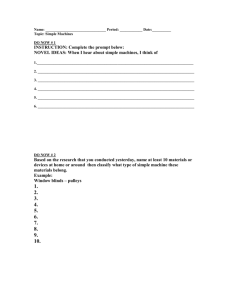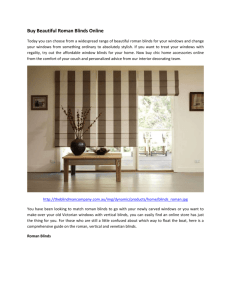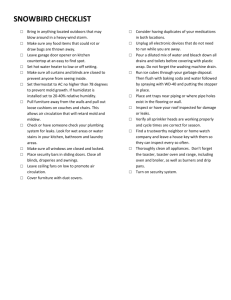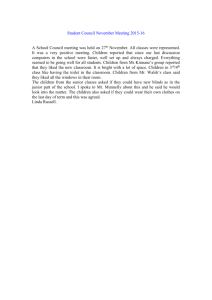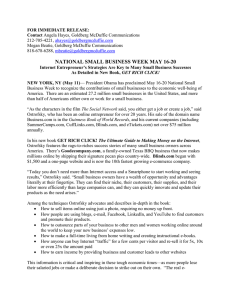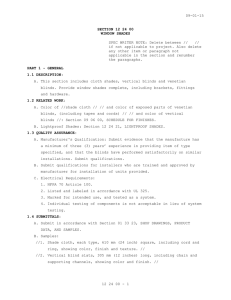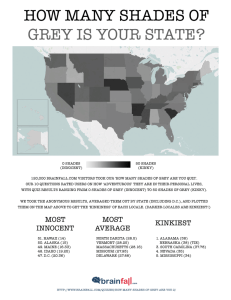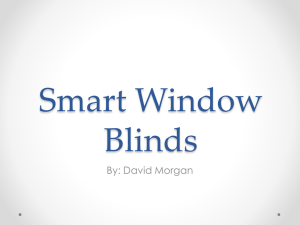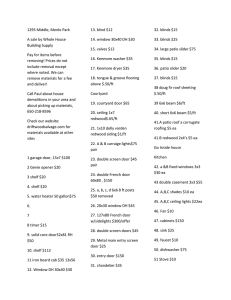06-01-14 SPEC WRITER NOTES: 1. Use this section only for NCA
advertisement
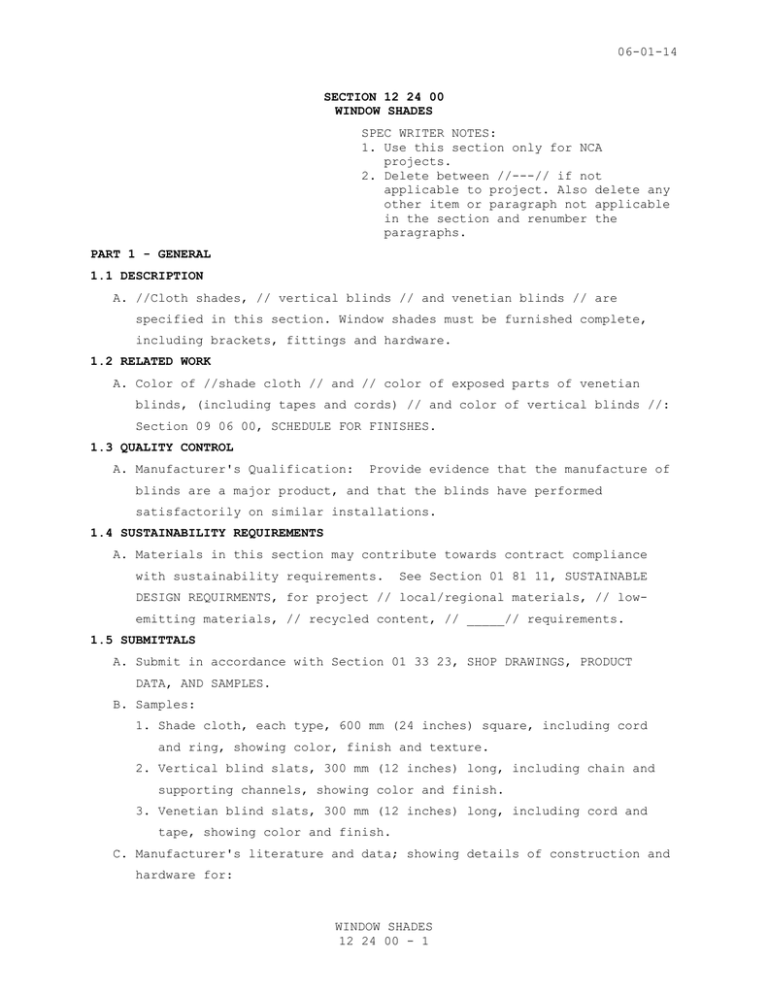
06-01-14 SECTION 12 24 00 WINDOW SHADES SPEC WRITER NOTES: 1. Use this section only for NCA projects. 2. Delete between //---// if not applicable to project. Also delete any other item or paragraph not applicable in the section and renumber the paragraphs. PART 1 - GENERAL 1.1 DESCRIPTION A. //Cloth shades, // vertical blinds // and venetian blinds // are specified in this section. Window shades must be furnished complete, including brackets, fittings and hardware. 1.2 RELATED WORK A. Color of //shade cloth // and // color of exposed parts of venetian blinds, (including tapes and cords) // and color of vertical blinds //: Section 09 06 00, SCHEDULE FOR FINISHES. 1.3 QUALITY CONTROL A. Manufacturer's Qualification: Provide evidence that the manufacture of blinds are a major product, and that the blinds have performed satisfactorily on similar installations. 1.4 SUSTAINABILITY REQUIREMENTS A. Materials in this section may contribute towards contract compliance with sustainability requirements. See Section 01 81 11, SUSTAINABLE DESIGN REQUIRMENTS, for project // local/regional materials, // lowemitting materials, // recycled content, // _____// requirements. 1.5 SUBMITTALS A. Submit in accordance with Section 01 33 23, SHOP DRAWINGS, PRODUCT DATA, AND SAMPLES. B. Samples: 1. Shade cloth, each type, 600 mm (24 inches) square, including cord and ring, showing color, finish and texture. 2. Vertical blind slats, 300 mm (12 inches) long, including chain and supporting channels, showing color and finish. 3. Venetian blind slats, 300 mm (12 inches) long, including cord and tape, showing color and finish. C. Manufacturer's literature and data; showing details of construction and hardware for: WINDOW SHADES 12 24 00 - 1 06-01-14 1. Cloth and window shades. 2. Vertical blinds. 3. Venetian blinds. 1.6 APPLICABLE PUBLICATIONS A. Publications listed below form a part of this specification to extent referenced. Publications are referenced in text by the basic designation only. Comply with applicable provisions and recommendations of the following, except as otherwise shown or specified. SPEC WRITER NOTES: 1. Remove reference citations that do not remain in Part 2 or Part 3 of edited specification. 2. Verify and make dates indicated for remaining citations the most current at date of submittal; determine changes from date indicated on the TIL download of the section and modify requirements impacted by the changes. B. American Society for Testing and Materials (ASTM): A167-99(2009) Stainless and Heat-Resisting Chromium-Nickel Steel Plate, Sheet and Strip B221-13 Aluminum-Alloy Extruded Bars, Rods, Wire, Shapes, and Tubes D635-10 Rate of Burning and/or Extent and Time of Burning of Self-Supporting Plastics in a Horizontal Position D648-07 Deflection Temperature of Plastics Under Flexural Load in the Edgewise Position PART 2 - PRODUCTS SPEC WRITER NOTES: 1. Update material requirements to space with applicable requirements (types, grades, classes, and other related items) specified in the referenced Applicable Publications. 2.1 MATERIALS A. Shade Cloth: // translucent // opaque.// B. Staples (For Cloth Window Shades): Nonferrous metal or zinc-coated steel. C. Stainless Steel: ASTM A167. D. Cords for Venetian Blinds: No. 4 braided nylon or No. 4-1/2 braided cotton having not less than 175 pounds breaking strength. E. Extruded Aluminum: ASTM B221. WINDOW SHADES 12 24 00 - 2 06-01-14 2.2 VENETIAN BLINDS A. 50 mm (2 inch slat) // Type II, 25 mm (1 inch slats) // fabricated of aluminum. Pre-production sample is not required. 2.3 VERTICAL BLIND LOUVER BLADES A. Rigid polyvinyl chloride, light stable, not less than 0.6 mm (0.025 inch) thick, 90 mm (3-1/2 inches) wide, and with beaded edges on each side of not less than 1.2 mm (0.050 inch). B. Louvers to withstand 80C (180 degrees F) head chamber for thirty minutes without distortion, shrinkage, or stretching for no more than one half of one percent as tested by ASTM D648. C. Louvers to be opaque and of plain finish, and permanently flame retardant as tested by ASTM D635. 2.4 FASTENINGS A. Zinc-coated or cadmium plated metal, aluminum or stainless steel fastenings of proper length and type. B. Except as otherwise specified, provide fastenings for use with various structural materials as follows: Type of Fastening Structural Material Wood screw Wood Tap screw Metal Case-hardened, selftapping screw Sheet Metal Screw or bolt in expansion shields Solid masonry Toggle bolts Hollow blocks, wallboard and plaster 2.5 FABRICATION A. Fabricate // cloth shades // venetian blinds // vertical blinds // to fit measurements of finished openings obtained at site. B. Cloth Window Shades: 1. Rolling type, constructed of shade cloth mounted on rollers. 2. Shade cloth to have plain sides, and with hem at bottom to accommodate wood slat. 3. Separate shades are required for each individual sash within opening. WINDOW SHADES 12 24 00 - 3 06-01-14 4. Length of shades to exceed height of window approximately 300 mm (12 inches) measured from head to sill, in addition to material required to make-up hem: a. Provide rollers with spindles, nylon bearings, tempered steel springs, and all other related accessories required for positive action. b. Provide rollers of diameter recommended by shade manufacturer. c. Staple shade cloth to wood rollers to prevent wrinkling or folding, and on line parallel to axis of rollers so that shade will hang plumb. d. Space staples not over 90 mm (3-1/2 inches) on centers. Use of tacks is prohibited. e. Wood slats to be smooth, tapered, and inserted in the bottom hem of the shade cloth. f. Eyelets to have clear openings large enough to accommodate cords; edges of eyelets must not cut into cloth when set. g. Cords to be of sufficient length to permit shades to be drawn to bottom of opening with ends looped and held with cord rings. Attach cords to hems through metal eyelets in center of slats in bottom hems. C. Venetian Blinds: 1. Venetian blinds to have // 25 mm (1 inch) // 50 mm (2 inch) // width horizontal slats positioned within ladder tapes. 2. Multiple blinds in openings are to be of same type and divided at mullions. 3. Head-rails to fully enclose operating mechanism on three sides and ends. 4. Bottom rails to be fully enclosed to prevent contact of tapes and sill at underside. 5. //In lobbies, bottom rails and head boxes to be aluminum. // 6. Finish concealed metal work of head-rails including concealed mechanism, with one shop coat of paint. Do not paint parts that have non-rusting finish, or parts where motion of friction occurs. D. Vertical Blinds: Traversing type with rotating louvers positioned between window head and sill rails, and including hardware, brackets, anchors, fastenings and accessories. 1. Provide one piece, extruded aluminum head and sill rails, full length with capped ends. WINDOW SHADES 12 24 00 - 4 06-01-14 a. Provide manufacturer's standard finish for concealed surfaces. b. Match finish on windows for exposed surfaces. 2. Provide carrier trucks for head and sill rails for each louver blade, with two, aluminum or steel, ball bearing wheels, mounted on acetal resin axles. 3. Louvers to be held fixed until reset by control. 4. Stainless steel, full hard, flexible spacer links to space and stabilize each truck by passing smoothly between stabilizer guides on each truck; no glides or sliders not allowed. 5. Louvers to traverse at any angle without binding. 6. Louvers to be kept taut between head and sill rails with a minimum of one to a maximum of 1 Kg (2-1/2 pounds) of spring tension. 7. Traversing to be split draw and accomplished by an anodized aluminum, spiral lead screw extending the full length of the channel, actuating a lead nut, and controlled by a nickel plated brass or stainless steel bead chain; blinds must pack when traversed to not more than 11 mm (7/16-inch) per louver plus space for end caps and end spacer tubes. 8. Louvers to overlap not less than 9 mm (3/8-inch). 9. Louvers to operate manually in opposite direction from normal traverse, and end louver must be firmly fixed by a friction spacer or anti-creep pin. PART 3 - EXECUTION 3.1 INSTALLATION A. Cloth Window Shades: Mount window shades on end of face brackets, set on metal gussets, or casing of windows as required. Provide extension face brackets where necessary at mullions. // In existing buildings, provide brackets similar to those on existing windows.// 1. Locate rollers in level position as high as practicable at heads of windows to prevent infiltration of light over rollers. 2. Where extension brackets are necessary, on mullions or elsewhere, for alignment of shades, provide metal lugs, and rigidly anchor lugs and brackets. 3. Place brackets and rollers so that shades will not interfere with window and screen hardware. 4. //Mount shades at wire mesh window guards on head rails of hinged frame. // WINDOW SHADES 12 24 00 - 5 06-01-14 5. //Mount shades at detention, or protection screens on head rail (room side) of hinged frame, with face brackets located approximately 38 mm (1-1/2 inches) from outside edges. // 6. Shade installation methods not specifically described, are subject to approval of RE/COR. B. Venetian Blinds: Support blinds in level position by brackets and intermediate supports that will permit easy removal and replacement of units without damage to blind, or adjacent surfaces. Provide at least two fasteners for each bracket or other support. 1. Install blinds between jambs on window openings with steel trim. Mount brackets on trim reveal, flush with face of trim and secure with steel screws. 2. Install blinds between jambs on window openings with wood trim. Mount brackets on trim or on wood plaster-mold set against plaster or other wall finish, and secure in place with screws. 3. Mount brackets and intermediate supports of lobby blinds on face of trim members, and secure with stainless steel standard tap or thread-forming machine screws, or by cadmium-plated molley or toggle bolts. Penetrate through and lock screws and bolts behind steel sub-frame. 4. Where blinds abut glass partitions of Vestibules, extend head rails to trim at head of partition frame with slats sufficiently long to clear transom bars. 5. Provide one brush (for each 1 to 50 blind) of an approved type, suitable for cleaning blinds. C. Vertical Blinds: 1. Support blinds in level position that will permit easy removal and replacement of units without damage to blind or adjacent surfaces. 2. Provide at least one fastener for each 500 mm (20 inches) of width, with end screws maximum of 75 mm (three inches) from end. 3. Protect vertical blinds against defacements, warpage of slats, or bending of rails. Remove and replace warped or damaged slats, or bent rails. 4. Repair scratches or other defacements at the Contractor's expense and as approved by the RE/COR. - - - E N D - - - WINDOW SHADES 12 24 00 - 6
